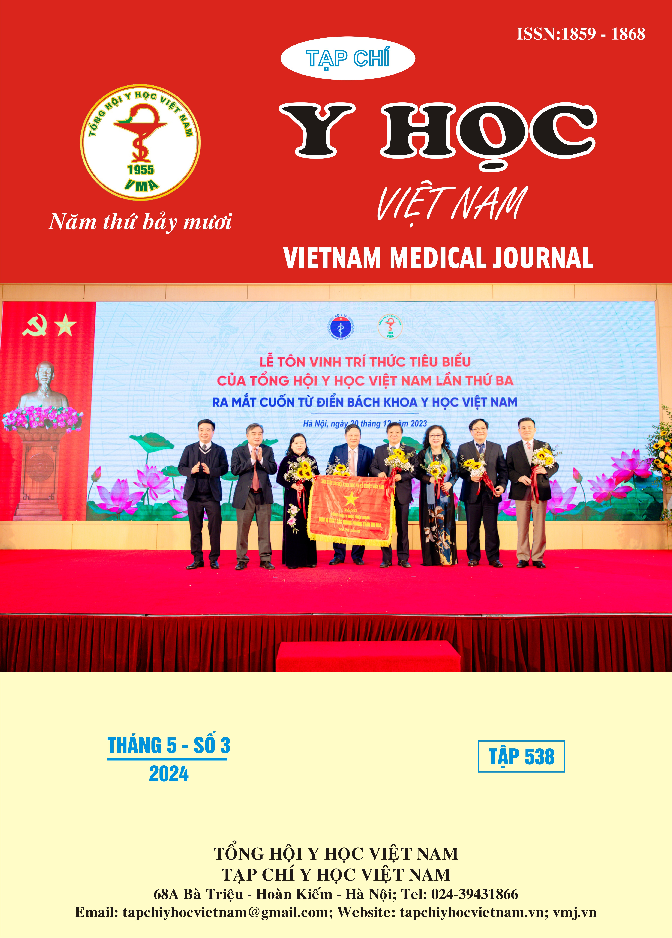RESULTS OF TREATMENT OF CLOSED FEMORAL DIAPHYSEAL FRACTURE BY SIGN NAIL AT THANH HOA GENERAL HOSPITAL
Main Article Content
Abstract
Objective: Evaluating the results of treatment of closed femoral diaphyseal fracture with SIGN nails at Thanh Hoa General Hospital. Subject and method: Cross-sectional descriptive study, retrospective records and longitudinal follow-up. The study was conducted from January 2021 to July 2023. Results: There were 31 patients with static latch, accounting for 79.5%, 8 patients with dynamic latch (20.5%). All 100% of patients screwed the pin into the nail hole. Evaluate the results according to Roy - Sender standards based on the images of straight-tilt X-rays after surgery and the healing status of the initial surgical wound. The results showed that the good rate was 87.18% and the good rate was 7.69%. There were no cases of bent or broken nails. There were 2 cases of delayed bone healing (5.1%). Conclusion: SIGN nail helps immobilize the fracture, control the length and ability to rotate the axis of the limb and is a good choice in complex closed femoral diaphyseal fracture.
Article Details
Keywords
closed femoral diaphyseal fracture, intramedullary nails, SIGN nails
References
2. Dương Đình Toàn (2005). Đánh giá kết quả điều trị gãy kín thân xương đùi ở người lớn bằng đinh SIGN có chốt tại bệnh viện Việt Đức từ 2004-2005, Luận văn tốt nghiệp bác sỹ nội trú, Hà Nội
3. Mã Văn Sánh (2016). Đánh giá kết quả điều trị gãy thân xương đùi bằng đinh SIGN tại Bệnh viện đa khoa Thanh hóa. Kỷ yếu Hội nghị khoa học tuổi trẻ các trường ĐH, Cao đẳng Y Dược Việt Nam lần thứ XVIII. Tr. 72-79.
4. Vũ Trường Thịnh, Dương Ngọc Lê Mai, Trần Minh Long Triều, Nguyễn Xuân Thùy, Lê Viết Thống. (2021). Đánh giá kết quả điều trị gãy kín thân xương đùi phức tạp bằng đinh sign tại Bệnh viện Hữu Nghị Việt Đức. Tạp Chí Nghiên cứu Y học, 145(9), 158-169.
5. Lương Đình Lâm và cộng sự (2000). Thông báo bước đầu về kết quả đóng đinh có chốt ngược dòng từ gối lên để điều trị gãy liên lồi cầu, trên lồi cầu và 1/3D xương đùi", Tạp chí y học chuyên ngành chấn thương chỉnh hình, tập 4, số 4, tr. 204-207.
6. Wang W.C., Xie L., Zhang Q. (2001). “Clinical use of interlocking intramedullary nail treating in complex and nonuion fracture of femur and tibia”, Human Yi Ke Da Xue Xue Bao, 26(2), pp. 136-138
7. Ricci and et al (2001). “Retrograde versus Antegrade nailing of FemoralShaft Fracture”, J Orthop Trauma, 15(3), pp. 161-169.
8. Wolinsky P, Tejwani N, Richmond JH, Koval KJ, Egol K, Stephen DJ., (2002). Controversies in intramedullary nailing of femoral shaft fractures. Instr Course Lect. 2002; 51:291–303
9. Christian Krettek (2001). “Intramedullary nailing”, AO principles of fracture management, pp. 195-219


